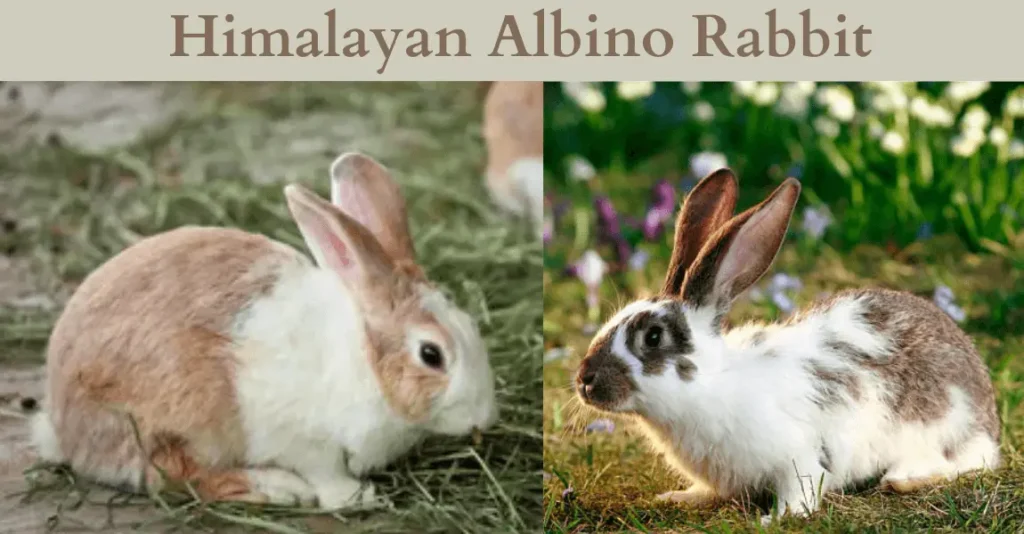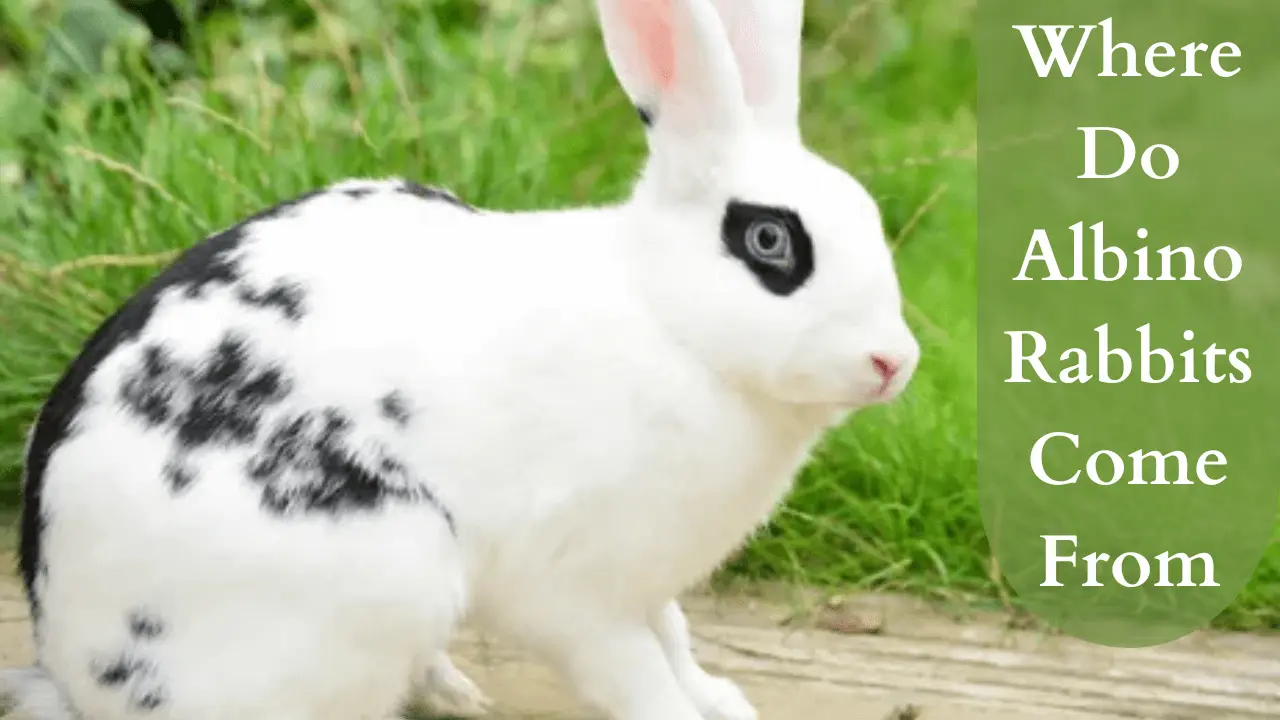Albino rabbits with their distinctive white fur and pink eyes are a fascinating subject for animal lovers and scientists alike. Unlike typical rabbit congeners albino rabbits are the result of a unique genetic mutation that affects melanin production giving them a distinctive appearance.
This interesting condition not only sets them apart visually but also presents unique care needs and challenges. To understand where do albino rabbits come from so it is necessary to explore their genetic origins, natural phenomena and the impact of selective breeding.

In this article, we will delve into the world of albino rabbits highlighting their origins, characteristics, and the specialized care they require to thrive. Whether you are considering adopting an albino rabbit or are simply curious about these fascinating creatures. This comprehensive guide will give you valuable information and knowledge.
- The Origins of Albino Rabbits:
- Natural Occurrence of Albino Rabbits:
- Breed of where do Albino Rabbits come from:
- Types of Albino Rabbits by Fur Color:
- Types of Albino Rabbits by Eye Color:
- Characteristics of Albino Rabbits:
- Lifespan & Factors Influencing Albino Rabbit Breeds:
- Health Care Tips for the Lifespan of Albino Rabbits:
- Albino Rabbits in Research and Culture:
- Conclusion:
- Frequently Asked Question:
The Origins of Albino Rabbits:
The albino hare is not a separate species but is the result of a genetic mutation. The mutation affects the production of melanin which is the source of color in the fur, skin and eyes of many animals. Albinism can occur in a wide range of species including humans, birds, reptiles and mammals.
Genetic basis of albinism:
Albinism in rabbits is caused by a mutation in the TYR gene, which codes for the enzyme tyrosinase. Tyrosinase is essential for the production of melanin. If a rabbit has a mutation in both copies of the TYR gene (homozygous recessive inheritance) the rabbit will not be able to produce melanin resulting in the white coat and pink eyes characteristic of albino rabbits. The pink color of the eyes is caused by light reflected from the blood vessels in the retina because there is no pigment in the iris.
Genetics of Albinism:
Albinism is inherited as an autosomal recessive trait. In order for a rabbit to become albino it must inherit two copies of the mutated gene from each parent. If a rabbit inherits only one copy of the mutant gene it will not develop the albino phenotype but will be a carrier. If two rabbits carrying the mutated gene are mated there is a 25% chance that they will become albino a 50% chance that they will become carriers, and a 25% chance that they will become non-carriers.
Natural Occurrence of Albino Rabbits:
In the wild, albino rabbits are relatively rare due to the survival disadvantages associated with albinism. Albino rabbits lack the natural camouflage that helps protect them from predators. Their white fur makes them easier to spot and the lack of pigment in their eyes can lead to impaired vision reducing their chances of survival. However, where do albino rabbits come from it can still be found in the wild.
Adaptation and selective breeding:
Domestication plays an important role in the prevalence of albino rabbits. Domestic rabbits are bred for various traits such as coat color, coat texture, body type and temperament. Albinism a very unique trait has been selectively bred in certain rabbit breeds. For example, New Zealand White rabbits are bred specifically for albinism and are commonly used in laboratory research because of their uniform genetic structure and ease of handling.
Breed of where do Albino Rabbits come from:
Albino rabbits characterized by white fur and pink eyes, come in a variety of breeds. These breeds have been selectively bred to exhibit the albino trait and are popular with rabbit lovers and researchers. Below we’ll take a look at some of the most common albino rabbit breeds highlighting their unique characteristics and what sets them apart from each other.
New Zealand White:

The New Zealand White rabbit is perhaps the best known breed of albino rabbit. Originally from the United States this breed was bred in the early 20th century and has since become a dominant species in both the pet industry and scientific research.
- Appearance: New Zealand Whites are large rabbits that weigh between 9 and 12 pounds. They have a strong muscular build, pure white fur and bright pink eyes.
- Temperament: Known for their docile and friendly nature, New Zealand Whites make excellent pets. They are also easy to handle which is one of the reasons why they are widely used in laboratories.
- Uses: As well as being popular pets New Zealand Whites are widely used in scientific research due to their stable genetic structure and calm behavior. They are also bred for meat production and demonstration purposes.
Florida White:

The Florida white rabbit is another breed in which albino rabbits play an important role. This breed was developed in the 1960s by crossing smaller rabbit breeds to create a compact and efficient rabbit for breeding meat and laboratory animals.
- Appearance: Florida Whites are smaller than New Zealand Whites and typically weigh between 1.5 and 2 kg. They have a compact, rounded body, white fur and pink eyes.
- Temperament: Florida Whites are known for their calm and gentle nature. They are easy to handle making them suitable both as companion animals and for research.
- Uses: Originally developed for meat production and laboratory purposes. Florida Whites are becoming increasingly popular as companion animals due to their manageable size and friendly nature.
Himalayan:

The Himalayan rabbit, also known as the Russian or Chinese rabbit has a unique appearance due to its albino-like features and the colored spots on its ears, nose, legs and tail.
- Appearance: The slender elongated body has white fur and characteristic dark spots. The eyes are pink or red which is characteristic of albinism.
- Temperament: Himalayan rabbits are gentle and good-natured known for their playful and affectionate behavior. They are popular with families and rabbit lovers.
- Uses: Although Himalayan rabbits are mainly kept as pets they are also exhibited at rabbit shows because of their unique and striking appearance.
Californian:

The California Rabbit is another breed characterized by albino, spotted rabbits. This breed was developed in the early 20th century and is the result of crossbreeding New Zealand Whites, Himalayans, and chinchillas.
- Appearance: The California hare is a large rabbit usually weighing between 8 and 12 kilograms. They are stocky and muscular with white fur and black spots on their ears, nose, feet, and tail. Their eyes are pink or red.
- Temperament: California Rabbits are known for their gentle and friendly nature making them easy to handle and excellent pets. They are also suitable for exhibition.
- Uses: The California Rabbit is a popular choice for meat due to its size and fast growth. They are also used for research purposes and are often seen at rabbit shows.
Types of Albino Rabbits by Fur Color:

Albino rabbits are primarily distinguished by their lack of melanin, resulting in their characteristic white fur and pink eyes. However, within the broader category of albino rabbits, there are some variations in fur texture and minor color distinctions that can be observed. Here are the main types of albino rabbits categorized by these subtle differences:
Pure White Albino Rabbits:
The classic albino rabbit has pure white fur a direct result of the absence of melanin. These rabbits are entirely devoid of any pigment in their fur, skin, or eyes.
- New Zealand White: This is the most common breed featuring pure white albino rabbits. They are characterized by their large size, muscular build, and bright pink eyes.
- Florida White: Smaller than the New Zealand White and the Florida White also has pure white fur and pink eyes with a compact and rounded body.
Pointed White Albino Rabbits:
The pointed white albino hare has unique characteristics most of its body is white but it has dark patches on its ears, nose, legs and tail. These spots are not the result of melanin production but of the expression of temperature-sensitive color another genetic characteristic.
- Himalayan: Himalayas are medium-sized rabbits with white bodies and dark points typically black or brown on their extremities. They have pink or red eyes characteristic of albinism.
- Californian: Similar to the Himalayan Californian rabbits are larger and have dark points on their ears, nose, feet, and tail. They are often used for meat production and also have pink or red eyes.
Satin Albino Rabbits:
Albino satin-finned rabbits are distinguished by the unique texture and shine of their fur. The satin color of their fur is the result of a genetic mutation that affects the structure of the fur, giving it a shiny, satin look.
- Satin: This breed can come in an albino variety featuring pure white fur that shines with a distinctive luster. These rabbits are medium to large-sized and have the typical pink eyes of albinos.
- Mini Satin: A smaller version of the Satin breed Mini Satin rabbits also exhibit the glossy white fur and pink eyes. They are popular as pets rabbit due to their manageable size and attractive appearance.
Rex Albino Rabbits:
Rex Albino rabbits are known for their plush velvety fur which is a result of a mutation that causes the hair to stand upright rather than lying flat.
- Rex: The standard Rex breed can have an albino variety featuring the soft, dense fur and pink eyes. These rabbits are medium-sized and have a distinct luxurious coat texture.
- Mini Rex: Similar to the Rex but smaller in size Mini Rex Rabbits also come in an albino form. They are favored as pets for their compact size and unique fur texture.
Albino Variations in Different Breeds:
While pure albinos and albinos with colored spots are the most common presentations albinism can also appear in other rabbit breeds sometimes resulting in unique variations depending on the breed’s genetic history.
- Lionhead: Lionhead rabbits can develop albinism resulting in a white rabbit have red eyes the fluffy mane that characterizes the breed. Albino Lionheads have white fur and pink eyes with a mane that adds interest.
- Mini Rex: Mini Rex Rabbits are known for their soft, velvety fur. When albinism occurs in this breed the result is a pure white rabbit with red eyes the same luxurious coat texture and pink eyes making it a unique and attractive choice for rabbit fanciers.
Types of Albino Rabbits by Eye Color:

Albino rabbits are distinguished by their lack of pigment resulting in a white coat and unique eye colour. Although albino rabbits are usually known for their pink or red eyes there are varieties that also include blue eyes. These differences in eye colour are the result of specific genetic variations and can be very interesting to study. Here we will look at the species of albino rabbits classified by eye color albino with pink/red eyes and albino with blue eyes.
1- Pink/Red-Eyed Albino Rabbits:
Pink or red-eyed albino rabbits are the most common type of albino rabbit. The pink or red color is due to the absence of pigment in the iris allowing the blood vessels in the eyes to be visible.
Genetics:
This type of albinism is caused by a mutation in the TYR gene which affects the production of melanin. The complete lack of melanin results in the pink or red appearance of the eyes.
Common Breeds:
- New Zealand White: This breed is a classic example of pink-eyed albino rabbits widely used in research and as pets.
- Florida White: Another breed featuring pink-eyed albinos known for their compact size and gentle nature.
- Californian: While primarily known for their colored rabbit point’s pure albino Californians also display pink eyes.
Characteristics:
- Vision: Pink-eyed albino rabbits can have vision issues due to the lack of pigment which can affect their ability to perceive depth and handle bright light.
- Sensitivity: These rabbits may be more sensitive to sunlight and should be protected from direct exposure to prevent eye strain and potential damage.
2- Blue-Eyed Albino Rabbits:
Albino rabbits with blue eyes are less common than pink-eyed rabbits. The blue color is caused by a different genetic mutation which still results in a lack of pigment but reflects light differently on the iris.
Genetics:
Blue-eyed albinism can result from a mutation in the same TYR gene or other genes affecting pigment production. The specific genetic pathway leads to blue eyes instead of pink.
Common Breeds:
- Himalayan: While typically known for their dark points some Himalayan rabbits can have blue eyes especially in albino variations.
- White Vienna: This breed is known for its striking blue-eyed albinos often bred specifically for their unique eye color.
Characteristics:
- Vision: Blue-eyed albino rabbits generally have better vision compared to pink-eyed albinos, though they may still be sensitive to bright light.
- Popularity: Blue-eyed albinos are often prized for their rarity and striking appearance making them popular among breeders and rabbit enthusiasts.
Characteristics of Albino Rabbits:
Albino rabbits have some distinct characteristics that set them apart from other rabbits. Understanding these characteristics can help to provide better care and ensure the welfare of albino rabbits.
Physical Traits:
- White Fur: The most obvious characteristic of albino rabbits is their pure white fur. This lack of pigment extends to their skin as well which is also pale.
- Pink Eyes: Albino rabbits have pink or red eyes due to the reflection of light from the blood vessels in the retina.
- Sensitive Skin: The absence of melanin makes the skin of albino rabbits more sensitive to sunlight increasing the risk of sunburn and skin damage.
- Vision: Albino rabbits may have vision problems due to the lack of pigment in their eyes which can affect their depth perception and sensitivity to light.
Behavioral Traits:
- Timidity: Albino rabbits may be more timid and cautious possibly due to their visual impairments and heightened sensitivity to their environment.
- Social Interaction: Like other rabbits albino rabbits are social animals and can form strong bonds with their owners and other rabbits. Proper socialization and gentle handling are important for the welfare of albino rabbits.
Lifespan & Factors Influencing Albino Rabbit Breeds:
As with other rabbits the lifespan of albino rabbits can vary depending on a number of factors including breed, genetics, care and environment. Below is a table summarizing the average lifespan of common breeds of rabbits and the main factors that affect their lifespan.
| Albino Rabbit Breed | Average Lifespan | Factors Influencing Lifespan | Details |
| New Zealand White | 5-7 years | Genetics | Selective breeding for research and meat production may affect longevity. |
| Florida White | 5-8 years | Diet and Nutrition | Requires a balanced diet with high-quality hay, fresh vegetables, and pellets. |
| Himalayan | 5-10 years | Environment | Indoor housing with proper ventilation and protection from extreme temperatures. |
| Californian | 5-10 years | Healthcare | Regular veterinary check-ups and preventive care. |
| White Vienna | 7-12 years | Exercise and Enrichment | Needs adequate space and toys to stay mentally and physically stimulated. |
Key Points of Lifespan Factors Influence:
- New Zealand White Rabbits: These rabbits are known to be hardy and usually live 5-7 years. With proper care and a healthy diet their life expectancy can be extended.
- Florida White Rabbit: The Florida White Rabbit has a slightly longer lifespan than the New Zealand White Rabbit with an average lifespan of 5-8 years.
- Himalayan Rabbits: These rabbits can live up to 10 years especially if properly cared for and kept as pets. Their unique appearance and friendly nature make them a favorite among rabbit lovers.
- California Rabbit: Like the Himalayan rabbit the California rabbit has a lifespan of 5-10 years. They are known for their versatility in meat production, research and pets.
- White Vernal Rabbit: The longest-lived of the albino rabbits with a lifespan of 7-12 years. They have stunning blue eyes and a gentle temperament that is popular with rabbit lovers.
Health Care Tips for the Lifespan of Albino Rabbits:
Regardless of the breed albino rabbits have specific needs that must be met to ensure they live long and healthy lives. Here are some general care tips:
Diet and Nutrition:
- High-Quality Hay: The primary component of a rabbit’s diet should be fresh hay which aids in digestion and dental health.
- Fresh Vegetables: A variety of vegetables should be provided daily to ensure they receive essential vitamins and minerals.
- Pellets: Supplement their diet with high-quality rabbit pellets but in moderation to avoid obesity.
- Water: Clean, fresh water must always be available.
Housing and Environment:
- Spacious Living Area: Provide a large, clean, and safe living space, whether indoors or outdoors.
- Temperature Control: Ensure the living environment is not too hot or too cold as rabbits are sensitive to extreme temperatures.
- Enrichment: Offer toys and opportunities for mental stimulation to prevent boredom.
Health Care:
- Regular Vet Visits: Routine check-ups with a veterinarian specialized in rabbits.
- Vaccinations: Ensure they are up-to-date with necessary vaccinations to prevent diseases.
- Dental Care: Monitor their teeth regularly as rabbits’ teeth grow continuously and can develop issues if not worn down properly.
Socialization and Interaction:
- Companionship: Rabbits are social animals and thrive with companionship whether it’s another rabbit or regular interaction with humans.
- Gentle Handling: Handle them gently and regularly to build trust and reduce stress.
Albino Rabbits in Research and Culture:
Albino rabbits have made significant contributions to scientific research and have held a place in cultural contexts.
Scientific Research:
Albino rabbits especially New Zealand White rabbits are widely used in research because of their uniform genetic make-up and random temperament. They play an important role in research on genetics, toxicology, immunology, etc. Their use in research has contributed to advances in medicine pharmacology and biotechnology.
Cultural significance:
The albino rabbit also appears in folklore literature and art. In different cultures the unique appearance and rarity of albino rabbits have made them symbols of purity innocence and resurrection. They appear in stories myths and visual art that capture the imagination of people from different societies.
Also Read: https://thepetlive.com/albino-rabbits-cost/
Conclusion:
Albino rabbits’ white fur and striking pink eyes are the result of a genetic mutation that affects melanin production. Although rare in nature they have become more common in domestic rabbit populations through selective breeding. Understanding the origin genetics and characteristics of albino rabbits is essential to ensure their care and well-being.
Due to their unique characteristics albino rabbits require special attention to their breeding, nutrition, health and socialization needs. Albino rabbits have played an important role in research and have cultural significance in different contexts.
By appreciating the uniqueness of albino rabbits and considering their special needs we can ensure that these magnificent animals thrive in both domestic and scientific settings continue to fascinate and contribute to shaping our understanding of nature.
Frequently Asked Question:
What causes albinism in rabbits?
Albinism in rabbits is caused by a mutation in the TYR gene that affects the production of melanin. The lack of melanin causes the characteristic white coat and pink or blue eyes of rabbits.
Are albino rabbits rare?
Albino rabbits are very rare in the wild due to their unfavorable living conditions. However, through selective breeding albino rabbits are common in domestic breeds.
Where do albino rabbits come from?
White rabbits come from a number of species that have been selectively bred to be albino including the New Zealand White Rabbit, the Florida White Rabbit and the Himalayan Rabbit.
Are white rabbits natural?
Yes, white rabbits are natural. They are more common in domesticated rabbits that have been selectively bred.
Are white rabbits lucky?
In some cultures the white rabbit is considered a symbol of good luck and purity. However, this belief varies according to tradition and region.
What are the different breeds of white rabbits?
They include New Zealand White, Florida White and Vienna White. These breeds are bred for their white coats and unique characteristics.
What are pure white rabbits called?
Pure white rabbits are often referred to as albino rabbits. Breeds such as the New Zealand White Rabbit are famous for their pure white coat and albino characteristics.










